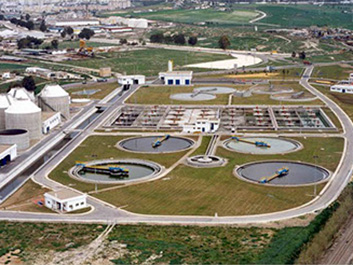The production of sulfide in sewage systems and waste water treatment plants (WWTP) is one the major environmental problems caused by such systems due to the noxious odor of sulfide even at low concentrations. Sulfide is highly toxic (and that is why our noses are so sensitive to it) and is considered a serious hazard for WWTP workers in unventilated areas. In addition, sulfide induced corrosion, which results in important economic losses due to the need to replace constantly metallic structures in the WWTP.
Sulfide is produced under anoxic conditions by sulfate reducing bacteria (SRB). These bacteria are able to respire using sulfate as a final electron acceptor, instead of oxygen like other bacteria or animals do, to degrade (oxidize) low molecular weight organic compounds. Sulfate is therefore reduced to sulfide, which accumulates in the water phase of WWTP tanks and is released eventually to the atmosphere. The production of sulfide by SRB, the so called “sulfide problem”, is common in other industrial sectors as well, such as the petroleum industry, tanneries, paper mills or even beverage industries, where anoxic conditions prevail.
In order to control the negative effects of sulfide production, several different physicochemical and biological methods have been proposed. One well-known biological strategy is the addition of nitrate to reduce the production of sulfide in waste water systems. However, the exact mechanisms in actions which result in the control of sulfide production by this method is still under debate.
Our group has demonstrated that biofilms growing in WWTP harbour a little-known group of bacteria, the so-called nitrate-reducing sulfide-oxidizing bacteria (NR-SOB). NR-SOB are chemolithotrophic bacteria, which means that they are able to obtain their energy from the oxidation of inorganic compounds (animals or SRB obtain their energy from the oxidation of organic compounds). Thus, NR-SOB are able to oxidize sulfide and elemental sulfur to sulfate, using nitrate as electron acceptor. Nitrate is then typically reduced to a gas compound, N2O or N2, which is released to the atmosphere. Therefore, NR-SOB and SRB maintain a close syntrophic relationship with SRB; SRB provide sulfide, the reduced substrate needed by NR-SOB to obtain energy, whereas NR-SOB replenish the sulfate in the system.
The addition of nitrate stimulates the activity of NR-SOB, allowing them to consume all the sulfide previously produced by SRB. In this way the net production of sulfide in the system approaches zero.
The presence of NR-SOB in biofilms, their high affinity for sulfide, their capacity to reduce nitrate to gaseous nitrogen (denitrifying the system and thus reducing the nitrogen load), and the fact that they are chemolithotrophic organisms, (i.e. are able to grow without an organic carbon source), makes the study of this physiological group very interesting. In addition, the syntrophic relationship between the SRB and NR-SOB is very interesting from a theoretical and applied perspective.
The biotechnological potential of this group of bacteria has been confirmed in the biological treatment of waste water and in the petroleum industry and it should be evaluated for others industrial sectors, where the production of sulfide causes problems, as well. Engineering the microbial behavior within extremely complex systems is a difficult objective which requires a deep understanding of the microorganisms involved, their metabolism and interactions, and their capacity to form and develop in microenvironments, such as biofilms. We still have a long way ahead of us.
Collaborations
Main collaborators from other labs:
Juan González, IRNAS-CSIC, Sevilla, Spain
José Antonio Morillo, Dept. Microbiology, University of Granada, Spain
Publications (more here)
García-de-Lomas J, Corzo A, González JM., Andrades JA., Iglesias E, Montero MJ. (2006). Nitrate promotes biological oxidation of sulfide in wastewaters: experiment at plant-scale. Biotechnol Bioeng 93: 801-811.
García-de-Lomas J, Corzo A, Portillo C, González JM., Andrades JA, Sáiz-Jiménez C, García-Robledo E. (2007). Nitrate stimulation of indigenous nitrate-reducing, sulphide-oxidising bacterial community in wastewater anaerobic biofilms. Water Res 41: 3121-3131.
Miranda, E, Bethencourt, M., Cano, M. J., Sánchez-Amaya, J. M., Corzo, A., García de Lomas, J., Botana, J., Fardeau, M. L., Ollivier, B. (2006). Biocorrosion of carbon steel alloys by the hydrogenotrophic sulfate-reducing bacterium Desulfovibrio capillatus isolated from a Mexican oil field separator. Corr. Science 48:2417-2431.
Bethencourt, M., García de Lomas, J., Corzo, A., Villahermosa, D., Matres V. (2010). Efecto de la biopelícula en la corrosión de aceros inoxidables austeníticos en estaciones depuradoras de aguas residuales. Rev. Metal 46: 37-51.
Corzo, A. García de Lomas, J., Villahermosa, D., Portillo, M.C., González, J.M., Andrades, J.A., García-Robledo, E., Sáiz-Jimenez, C., Bethencourt M. (2010): Microbial biofilms and the engineering of net sulfide production in wastewater treatment plants. En: Biofilms: Formation, Development and Properties. W. C. Bailey [ed]. Nova Science Publishers, Inc. pp 501-518. ISBN 978-1-61728-293-5.
Portillo, M. C., Villahermosa, D., Corzo, A., Gonzalez, J. M. (2011). Microbial community fingerprinting by differential display-denaturing gradient gel electrophoresis. Applied and Environmental Microbiology 77: 351-354.
Villahermosa, D., Corzo, A., González, J., Portillo, M.C., García-Robledo, E., Papaspyrou. S. (2013) Inhibitions of net sulfide production rate by nitrate in waste water experimental bioreactors. Kinetics and changes in the microbial community. Water, Air, & Soil Pollution 224:1738-1753.
Villahermosa Desirée; Corzo Alfonso; Garcia-Robledo Emilio; González Juan M; Papaspyrou. Sokratis (2016) Kinetics of indigenous nitrate reducing sulfide oxidizing activity in microaerophilic wastewater biofilms. PLOS One doi:10.1371/journal.pone.0149096
Funding
Biotechnology of microbial consortion formed by sulfate reducing bacteria and nitrate-reducing sulfide-oxidizing bacteria, (Biotecnología del consorcio microbiano formado por bacterias sulfatorreductoras y bacterias oxidadoras del sulfhídrico y reductoras de nitrato), P06-RNM-01787. PAI/EXCEL. Andalucía Regional Government (229.536 €). PI: A. Corzo, (2007-2010).





